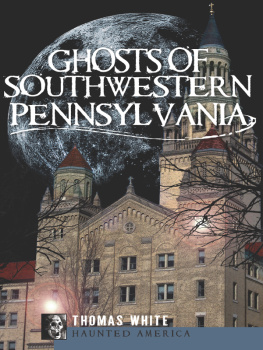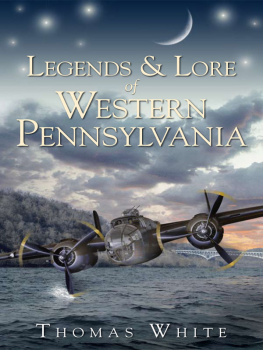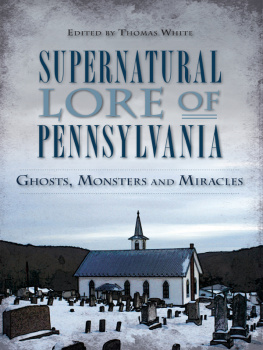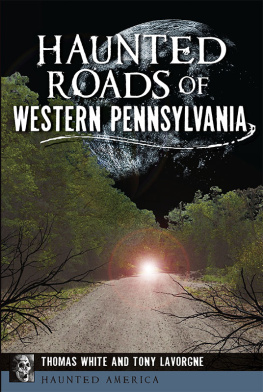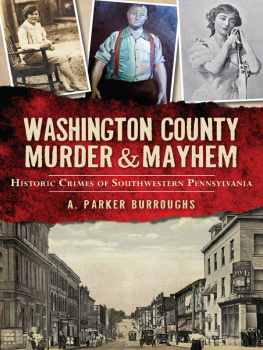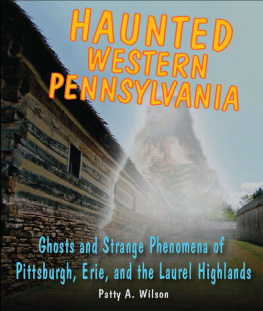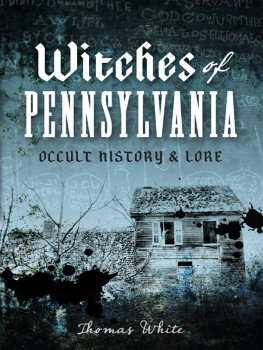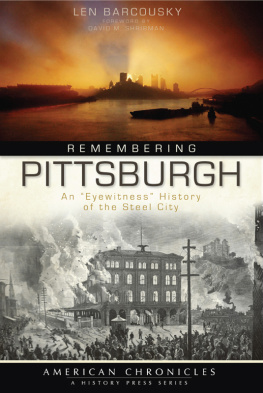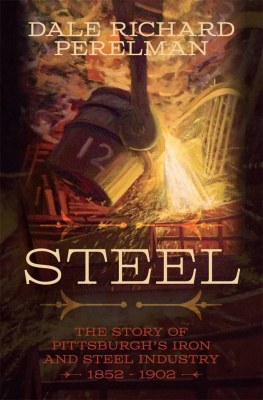

Published by Haunted America
A Division of The History Press
Charleston, SC 29403
www.historypress.net
Copyright 2010 by Thomas White
All rights reserved
Cover Image courtesy of Shane Henderson.
First published 2010
e-book edition 2012
ISBN 978.1.61423.417.3
Library of Congress Cataloging-in-Publication Data
White, Thomas.
Ghosts of Southwestern Pennsylvania / Thomas White.
p. cm.
Includes bibliographical references.
print edition ISBN 978-1-59629-923-8
1. Ghosts--Pennsylvania. I. Title.
BF1472.U6W49 2010
133.1097488--dc22
2010027411
Notice: The information in this book is true and complete to the best of our knowledge. It is offered without guarantee on the part of the author or The History Press. The author and The History Press disclaim all liability in connection with the use of this book.
All rights reserved. No part of this book may be reproduced or transmitted in any form whatsoever without prior written permission from the publisher except in the case of brief quotations embodied in critical articles and reviews.
In memory of Dolly and Ed Goslawski
CONTENTS
ACKNOWLEDGEMENTS
Gathering these ghost stories and writing this book required the help and support of many people. I need to thank my wife, Justina, and my children Tommy and Marisa for allowing me to have the time to complete this project and for their encouragement. I also want to thank my parents, Tom and Jean, and my brother, Ed, for their support and advice. Many people passed along stories and information to me over the years and helped verify facts and details. Brett Cobbey and Dan Simkins introduced me to the legend of the haunted Quaker church almost fifteen years ago and have helped me to collect details of the story. Aaron Carson used his superb research skills to help me track down obscure articles. He also proofread the manuscript. Lauren Lamendola provided me with an incredible array of information about St. Vincents College. John Schalcosky gave me enormous amounts of material on the Weitzel House and the Evergreen Hotel. Those sections could not have been completed without his help. My good friend Tony Lavorgne accompanied me on trips to many of the sites discussed in this book and photographed some of them. Once again, Michael Hassett gathered information and photographs for me in the New Castle area. Dr. Laurel Black, Nathan Jay Forbes and the rest of the Paranormal Society of IUP provided information about their investigations at West Overton. Elizabeth Williams, Paul Demilio and Renee Morgan took the time to proofread this manuscript on multiple occasions. The staff of the library and archives of the Heinz History Center, especially Robert Stakeley and Art Louderback, was extremely helpful as usual. Many other people assisted me in a variety of ways, including Angela Wells, E. Maxine Bruhns, Faith Hoenstine, Aimee Zellers, Emily Jack, Heather Frazier, Kelly Anderson, Brian and Terrie Seech, Brian Hallam, Ken Whiteleather, Kurt Wilson and Vince Grubb. Also, I would like to thank Hannah Cassilly and the rest of the staff of The History Press for giving me the opportunity to write this book.
INTRODUCTION
HAUNTINGS, LEGEND TRIPS AND MEMORY
It seems that people are always fascinated by ghosts and hauntings. A good ghost story can frighten us and still draw us in. Over the centuries, ghosts have meant many different things to many different people. Every culture since the beginning of recorded history has attempted to make contact with the dead and otherworldly spirits. From the ancient Greeks to Renaissance necromancers, nineteenth-century spiritualists to modern ghost hunters, there have always been people who seek out those who have died before them. Though their reasons for doing so have changed drastically over the millennia, their quest to reach out to the dead has continued. Some sought knowledge or prophecy that only spirits could provide. Some were desperate for contact with lost loved ones or confirmation of an afterlife. Others have sought ghosts purely for entertainment, just to catch a glimpse of the unknown. Many were merely charlatans who manipulated peoples belief in spirits for their own ends. Just as the motivations of the ghost hunters have changed, so have the motivations that have been ascribed to the ghosts that have allegedly appeared throughout history. Ghosts were said to have provided warnings or appeared to right an injustice. Some were sent by God to help, others by the devil to lead men astray. Certain ghosts guarded lost treasure. Other phantoms appeared at the site of their tragic demise, replaying the events of their death over and over. There are as many motivations for seeking ghosts (and ghosts seeking us) as there have been people watching for them. Despite all the technology, science and theory of the modern world, it seems as if there are more tales of hauntings than ever before.
While it is nearly impossible to easily summarize the importance of ghost beliefs in history, I can tell you why they interest me. There are actually a couple of reasons. The first is the element of mystery. Few things are as exciting as the unknown. Nothing describes this feeling better than the overused but very true quote by Albert Einstein: The most beautiful thing we can experience is the mysterious. It is the source of all true art and all science. He to whom this emotion is a stranger, who can no longer pause to wonder and stand rapt in awe, is as good as dead: his eyes are closed. Even in the area of academia, where I spend most of my days, it can be just as important to turn off the theory and critical outlook and try to experience at least some elements of folklore firsthand. In my area of specialization, public history, I sometimes have that opportunity because archives and museums serve as a bridge between academic ideas about history and the general public. At that intersection, the forces of traditional history and popular belief interact. It allows an opportunity to understand the uses of folklore and history among the general populace.
That being said, the second reason ghost stories fascinate me is because of the history that they both reveal and conceal. Ghost stories, like any other type of folklore, can tell you a tremendous amount about the people recounted in thembut even more about the people telling them. Sometimes the tellers of such tales (us) project their interpretation of events, fears and beliefs backward into the past or into the stories. The stories can carry warnings and reminders of dangers past and present. Other times ghost stories can be a form of memory that is transmitted, usually orally at first, through the community rather than being recorded as part of the historical narrative. The stories can carry the memory of disasters, forgotten people or marginalized groups or events that had a large impact locally but are otherwise viewed as minor from the outside. Ghost stories in that sense are a form of popular community history. Though the exact details of events may become skewed, the core message or meaning of the story or memory is retained.
Luckily for those of us who enjoy folklore, southwestern Pennsylvania is full of ghostly tales. The region has hundreds of stories of hauntings that range from the vaguely rumored to the well documented. For the past decade or so I have been actively collecting the folklore of this region. During that time I found that of all the types of folklore in western Pennsylvania, ghost stories and urban legends were the most common. In my first book,
Next page
